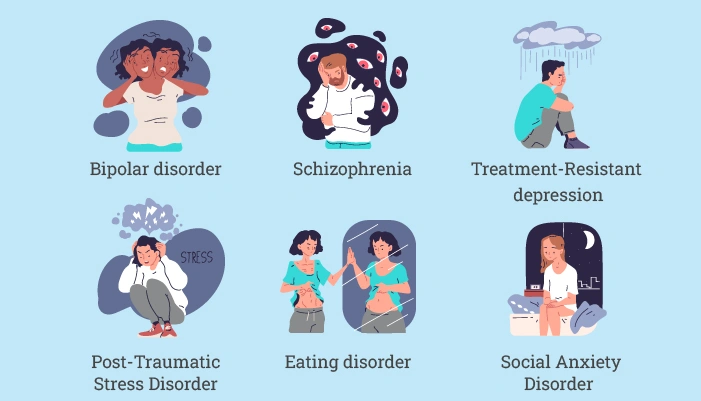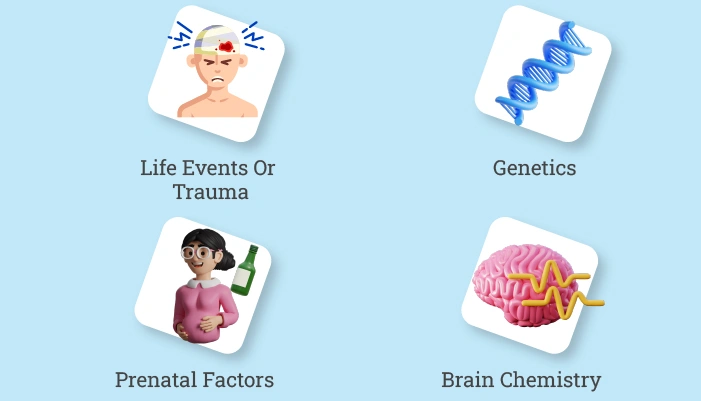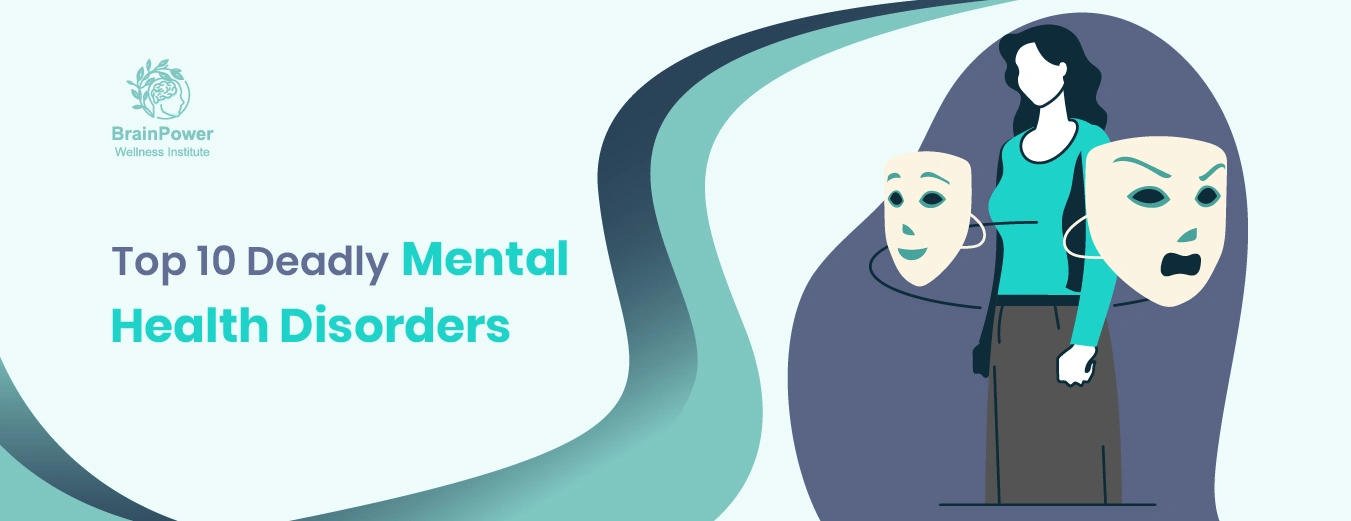When we hear about health conditions, we often think about cancer, heart issues, or diabetes. But what about the conditions that are invisible and can affect you mentally and physically?
These mental health conditions are challenging to live with and affect millions of people worldwide.
However, every individual’s experience with a mental disorder is personal; some mental conditions have a severe and complex nature and affect everyday life.
In this article, you will get to know the top 10 most severe and debilitating disorders that cause long-lasting effects on well-being.
What Are The Hardest Mental Health Conditions to Live With?
There is no single ‘hardest’ mental disorder; however, every person is determined by a different combination of personal factors and severity. Yet, mental health conditions impact different areas of life, particularly physical health, economic stability, and social connections.
Many individuals live with mental health disorders their whole life, which further increases the mortality risk.
Here are some of the most deadly mental health disorders.
1. Bipolar Disorder
Bipolar disorder is a chronic mental health condition that causes extreme shifts in mood and energy. They require hospitalization as extreme shifts of mood lead them to harm themselves.
Why is living with it challenging?
- Manic and hypomanic episodes make the individuals avoid social gatherings and urge them to make wrong decisions.
- The rapid changes of mood increase the risks of substance abuse and prompt them to stop treatment.
However, people experiencing Bipolar disorder can recover with a combination of psychotherapies and medications.
2. Borderline Personality Disorder
Borderline personality disorder is one of the hardest mental disorders that causes extreme mood fluctuations.
Why is living with it challenging?
- They have excessive fear of being rejected, abandonment issues, and emotional instability.
- They have chaotic relationships, as they idolize the other person and then push them away on the very next day.
- They have emotional weight that is intolerable.
- They engage in substance abuse, reckless driving, and have suicidal thoughts.
Moreover, it can be treated with dialectical behavioral therapy (DBT).
3. Schizophrenia
The most challenging and complex personality disorder that causes hallucinations, delusions, and sees things that have no existence in real life.
Why is living with it challenging?
- It severely affects cognitive abilities and impacts memory.
- People experiencing schizophrenia tend to remain alone, avoid social gatherings, and have self-harming thoughts.
However, the symptoms of schizophrenia are tricky to manage. A mental healthcare expert recommends Electroconvulsive therapy, Cognitive behavioral therapy, and antipsychotic medications to overcome the symptoms.
4. Treatment-Resistant depression (TRD)
It’s a state where depression doesn’t respond even after taking multiple treatments.
Why is living with it challenging?
- Individuals struggle with extreme sadness and hopelessness despite taking multiple treatments.
- It causes issues in everyday life activities, such as affecting work and relationships.
- People in this state withdraw from social activities and are more prone to suicide.
However, there are some advanced treatments that provide hope for treating resistant depression; these include Ketamine therapy, Electroconvulsive therapy, and Transcranial magnetic stimulation (TMS).
5. Post-Traumatic Stress Disorder
Post-traumatic stress disorder is a chronic and complex mental health condition s it occurs after experiencing a traumatic incident. It has a profound impact on daily functioning.
Why is living with it challenging?
- Individuals experiencing PTSD have flashbacks and nightmares of the traumatic events.
- They remain hypervigilant and in constant alertness.
- People experiencing PTSD remain emotionally numb, which severely affects their relationships.
- They are more prone to substance abuse and self-destructive behaviors.
However, it can be treated effectively with Cognitive Processing Therapy.
6. Eating disorder (Anorexia Nervosa)
Eating disorders are one of the deadliest and life-threatening conditions to live with, as they severely impact overall well-being. People experiencing an Eating disorder engage in self-starvation and have a persistent fear of gaining weight.
Why is living with it challenging?
- Individuals struggling with anorexia nervosa have an intense fear of gaining weight, which makes them vulnerable to making poor decisions.
- They tend to avoid social gatherings due to food-related anxiety.
However, it can be treated with cognitive behavioral therapy, family therapy, or by joining group therapies.
7. Obsessive Compulsive Disorder
Obsessive-compulsive disorder is a common mental health disorder in which a person experiences unwanted thoughts and compulsions. These thoughts can have various themes, such as fear of contamination, symmetry and order, and doubts.
Why is living with it challenging?
- The person feels compelled to ease these obsessions by constantly washing hands, arranging and re-arranging things, and seeking reassurances.
- Obsessions and compulsions are time-consuming, and as people spend hours doing repetitive behaviors just to alleviate anxiety.
OCD causes major discomfort, but it can be treated with a combination of medications and therapies such as Cognitive behavioral therapy, Exposure and Response Prevention (ERP), or Dialectical behavioral therapy.
8. Dissociative Identity Disorder
Dissociative identity disorder is a dangerous mental health disorder that severely affects everyday life activities. It is also known as multiple personality disorder.
Why is living with it challenging?
- People with DID have two or more identities in a single individual. Each identity has different emotions, memories, and conflicting goals.
- Individuals in this state have difficulty maintaining relationships.
- They struggle with this condition silently due to social stigma or stay quiet due to misunderstanding from others.
- There is a high mortality risk of suicide as well.
Fortunately, it can be treated with long-term therapies or by taking medications.
9. Severe Substance Use Disorder
A mental health condition in which there is uncontrolled use of a substance despite harmful consequences. This excessive use of substances leads to several brain changes that can cause issues in day-to-day life.
Why is living with it challenging?
- People with this disorder become so addicted that they have to take substances just to alleviate anxiety.
- It changes the brain’s structure, causing intense cravings, negative behaviors, and abnormal activities.
It can be treated with the right behavioral therapies and by joining a support group.
10. Social Anxiety Disorder
SAD is a debilitating condition known as social phobia. Individuals with this state tend to avoid social gatherings due to fear and anxiety.
Why is living with it challenging?
- It impacts relationships, routine, and work.
- People with this condition have self-consciousness, and they worry about being embarrassed and humiliating themselves.
However, Social Anxiety Disorder can be treated with the combination of medications and Cognitive behavioral therapy.
What Are The Major Risk Factors Of Mental Health Disorders?
Mental health conditions can arise due to various reasons, including the following:
1. Genetics
Genetics plays a major role in the development of mental health disorders. If any of your family members is struggling with any mental disorder, there is a high chance that you may also develop it. Mental health conditions are heritable and run in families.
2. Brain Chemistry
People who have differences in brain chemicals, such as neurotransmitters. Or if a person had a traumatic brain injury, they are more vulnerable to mental health disorders.
Moreover, individuals who are more prone to substance use are also at a high risk of developing certain mental health issues.
3. Prenatal Factors
If a mother has exposure to toxins, such as smoking, alcohol, or drugs, during pregnancy, it can affect the brain health of the baby. There are high chances of developing mental health conditions in the developing fetus.
4. Life Events Or Trauma
People who have experienced tragic life events, childhood trauma, or loss of loved ones can experience mental health conditions like PTSD, depression, or more. Individuals who have economic issues or socioeconomic situations are more prone to developing mental health conditions.
Achieve Mental Wellness At The Brainpower Wellness Institute
If you are looking for a mental healthcare specialist near you, Brainpower Wellness Institute is here to help! Our talented and experienced mental healthcare experts guide you to overcome the challenges of living with a mental health disorder. You can get evidence-based treatments with board-certified psychiatrists. We provide immersive and personalized treatments tailored to your specific condition. You can also get telepsychiatric services from the comfort of your home without the hassle of travelling.
Conclusion
Mental health conditions are dangerous and debilitating conditions that impact every aspect of life. The top 10 most deadly conditions are schizophrenia, PTSD, OCD, BPD, Bipolar disorder, social anxiety, and more. These conditions not only impact our personal lives but also affect our relationships and professional lives. These mental health conditions increase the rates of mortality or suicidal risk. However, all of the mental conditions can be treated with the help of professional healthcare experts. They address the root causes and recommend the treatments tailored to the unique condition of the individual.

Book an Appointment Today
Whether you’re ready for a consultation or have questions, our team is here to help. Contact us to book your appointment or call now for instant support.




